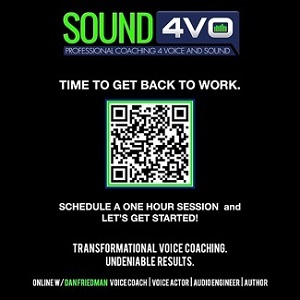|
Load Your Words With Attitude
& Emotion: Lift 'Hope' ... Feel 'Pain'!
By Marc Cashman
Cashman Commercials © 2008 Cashman Commercials  I’ve been struck many times - while listening to radio or TV commercials, various forms of narration or in the classes I teach - how many voice actors deliver their words with awesome articulation and precise projection, but detached delivery. I’ve been struck many times - while listening to radio or TV commercials, various forms of narration or in the classes I teach - how many voice actors deliver their words with awesome articulation and precise projection, but detached delivery. They’re quite adept at lifting the words off the page effortlessly, but fail to take the opportunity to color words or phrases with the appropriate attitude or emotion.
They sometimes forget to use their acting abilities to give depth to the words they speak. In voice acting, all our emotions and attitudes come through our voice. People can’t see our eyes or our body language like they can on stage or in film. The slightest nuance in the tone of our voice can convey myriad feelings; non-verbal utterances can convey even more.
But there are so many places in copy where we can really give the words the depth they need by feeling the words we’re saying and putting emotionality into them.
THE SOUND OF 'HOPE'
An example that came up in one of my classes occurred when we were working on a spot for a regional hospital, and one word that kept popping up was “hope.”
Ask yourself: what does hope sound like?
When you say the word just by itself, out of context, you tend to naturally say it on a down note. Hope. One word, spoken with a period after it.
But think about what hope means. Hope means to cherish a desire with anticipation, to wish for something, with some amount of expectation. It could be something you long for that’s realistic or unrealistic.
It’s an attitude or feeling that could be attainable.
And in the context of a hospital, and the feelings it evokes in potentially life-threatening situations, it’s a word with a very powerful meaning. So in this context, hope is a word we need to lift, and the attitude is a positive one.
PUT HOPE IN VOICE
When we say this word, we need to have hope in our heart in order to have hope in our voice. Because people can hear if we’re being sincere when we say this word or any word, for that matter.
Of course, we could say “hope” in a sarcastic way, a mean way, a forlorn or hopeless way.
But in a spot or narration for a hospital, we have to infuse the word “hope” with a positive attitude, with compassion and complete sincerity.
AND FEEL 'PAIN'!
On the other end of the spectrum, I hear the word “pain” a lot in copy, and I hear it thrown away. But this is another opportunity to infuse a word with emotion.
When you’re talking about pain, and you’re a sympathetic or empathetic person, when you say the word “pain” you should be wincing a bit. A listener can hear it in your voice.
And here’s a perfect example of how the sound of one word can provoke an emotional response: How many times have you called someone you know, and just by the tone of one word they use to answer the phone - hello - you can tell if something’s amiss?
It will provoke you to either say, “Hi, how’re ya doin’?” or “Are you okay?”
LOAD YOUR WORDS
So if one word can get that kind of response, just think of how thousands of your other spoken words and phrases are perceived.
There are innumerable words that you can color and give depth to whenever you come across them. These words are loaded with attitudes and emotions.
Don’t throw away the opportunity to infuse these words with the appropriate color, feeling and attitude. For example:
Whether they’re nouns, verbs, adjectives or adverbs, don’t throw these words away! For voice actors, words are easy to say and lift off the page effortlessly, but the listener needs to hear some thought and feeling behind those words.
BRING THESE TO LIFE ...
When you really start thinking about them, words are easy to bring to life when you say them with the appropriate feeling or attitude. Here are just a few examples:
Friendly, elegant, patriotic, confident, sultry, scary, stiff, sensual, helpful, funny, concern, evil, tiring, appetizing, sad, cautionary, breathless, wacky, tough, delicious, carefree, perky, nervous, stuffy, mellow, heroic, magical, cute, bored, sly, exciting.
In my classes, I have my students say these (and many other) words with their accompanying meaning (and sound), and also have them say them with their opposite meaning (and sound).
It’s funny to say “friendly” in an angry tone. It’s funny to say “confident” in a wimpy way!
And when you do this exercise, it becomes clear that, as voice actors, when we speak, we’re painting a picture for the listener, compensating for the fact that they can’t literally see us saying what we’re saying.
FEEL THE EMOTION
A lot of the copy you get as a voice actor will not be chock-a-block with words and phrases that you’ll be able to get behind emotionally. There’s no emotional hook in “2.9% APR financing for 60 months on all vehicles in stock.”
But the next time you do get some copy to perform that has any kind of emotional words or phrases or theme, sit with those words for a minute.
Feel the emotion behind the copy. Think about how you would feel, how someone you loved (or something, like a pet) would feel, and then deliver it with a newfound depth of feeling.
I guarantee you that you’ll start performing two-dimensional words on a page in three dimensions.
Marc Cashman creates and produces copy and music advertising for radio and television. Winner of over 150 advertising awards, he also instructs voice acting of all levels through his classes, The Cashman Cache of Voice-Acting Techniques in Los Angeles, offers One-on-One VO coaching via email or telephone, and is a sought-after public speaker in the advertising production and voice acting communities.
Email: cashcomm@earthlink.net
Phone: 661-222-9300
|
|
|
Tell Us What YOU Think!
Please Note: Since we check for spam, there will be a slight delay in the actual posting of your comment.
Comments
No comments have been posted yet. Hurry, and you could be the first!









click for new article alerts